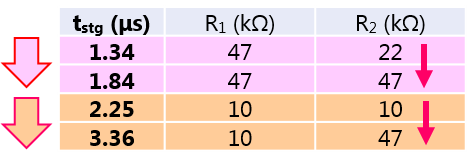- 半導體首頁
-
應用Automotive
Body Electronics
xEV
In-Vehicle Infotainment
Advanced Driver-Assistance Systems (ADAS)
Chassis
IndustrialInfrastructure
BEMS/HEMS
Factory Automation
Commercial Equipment
Consumer/PersonalIoT Equipment
Healthcare
Wearable Device
Mobile
Computer Peripherals
-
產品車用元件
Discrete Semiconductor
Diodes
電晶體
通用邏輯IC
Analog Devices
Digital Devices
Wireless Devices
※
: Products list (parametric search)
功率半導體※
: Products list (parametric search)
隔離器/固態繼電器Photocouplers
Digital Isolators
※
: Products list (parametric search)
MOSFETsIGBTs/IEGTs雙極性電晶體※
: Products list (parametric search)
Diodes※
: Products list (parametric search)
微控制器馬達驅動 ICs智能功率 ICs※
: Products list (parametric search)
電源管理 ICs線性 ICs※
: Products list (parametric search)
通用邏輯 ICs線性影像感測器其他產品其他產品
※
: Products list (parametric search)
-
開發/設計支援
開發 / 設計支援
-
技術知識
- 購買管道
- 型號 & 關鍵字搜尋
- 交叉搜尋
- 參數搜尋
- 線上庫存查詢跟購買
This webpage doesn't work with Internet Explorer. Please use the latest version of Google Chrome, Microsoft Edge, Mozilla Firefox or Safari.
型號需要超過三個文字以上 Search for multiple part numbers fromhere.
The information presented in this cross reference is based on TOSHIBA's selection criteria and should be treated as a suggestion only. Please carefully review the latest versions of all relevant information on the TOSHIBA products, including without limitation data sheets and validate all operating parameters of the TOSHIBA products to ensure that the suggested TOSHIBA products are truly compatible with your design and application.Please note that this cross reference is based on TOSHIBA's estimate of compatibility with other manufacturers' products, based on other manufacturers' published data, at the time the data was collected.TOSHIBA is not responsible for any incorrect or incomplete information. Information is subject to change at any time without notice.
型號需要超過三個文字以上
What can I do to increase the switching speed of a bias resistor built-in transistor (BRT)?
The switching speed of the bipolar transistor is defined as shown in Figure 1.
It takes the rise time (tr) for the BRT to turn on whereas it takes the sum of the storage time (tstg) and the fall time (tf) for the BRT to turn off. Table 1 shows examples of the results of measurements of these BRT characteristics.
The measurements were taken at a VCC of 5 V, switching the input voltage from 0 V to 5 V and vice versa. The load resistance is 1 kΩ.
| Type | R1 | R2 | tr (ns) | tstg (μs) | tf (μs) |
|---|---|---|---|---|---|
| RN1401 | 4.7 | 4.7 | 38 | 1.89 | 0.11 |
| RN1402 | 10 | 10 | 60 | 2.25 | 0.13 |
| RN1403 | 22 | 22 | 118 | 2.41 | 0.21 |

BRTs are mainly used as switches and remain in the saturation region while they are on. Therefore, the storage time (tstg), i.e., the time required to remove minority carriers from the base, accounts for the dominant portion of the switching time.
There are two considerations for reducing tstg:
a) Removing excessive carriers quickly
Excessive carriers accumulated in the base are removed mainly through R2 although the carrier removal path slightly differs, depending on the configuration of the preceding circuit. (If the output of the preceding circuit has low impedance at Low level, excessive carriers are also removed through R1). Therefore, BRTs with a low R2 value are suitable for increasing the switching speed.
b) Minimize the accumulation of excessive carriers.
This means that the depth of saturation of the BRT is reduced while it is on. To minimize the accumulation of excessive carriers, it is necessary to reduce the current applied to the base of the internal transistor (Ib). This can be achieved by 1) reducing the input current to the BRT (IB) and 2) reducing the base current of the internal transistor (i.e., increasing the current flowing to R2). Therefore, BRTs with a large R1 value and a large resistor ratio (R1/R2) are suitable. Note, however, that minimizing the accumulation of excessive carriers might reduce the depth of saturation, causing VCE(sat) to increase.



